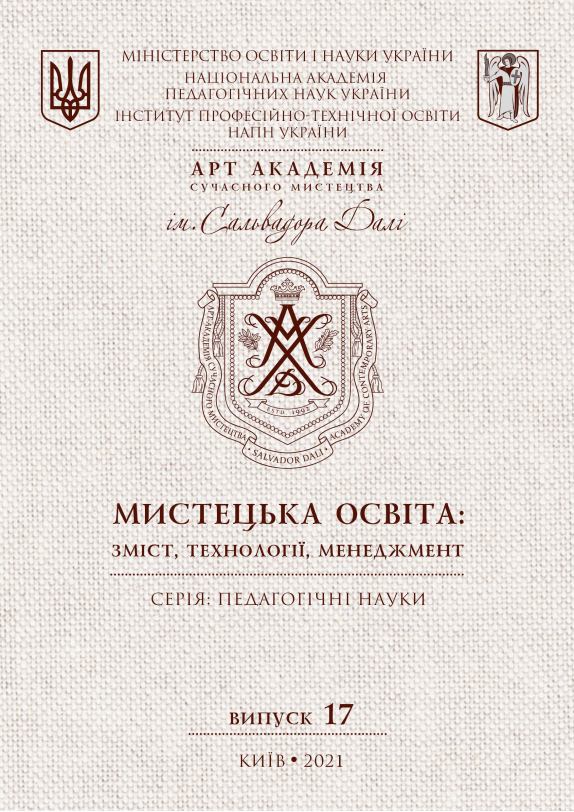PEDAGOGICAL POTENTIAL OF THE FOLK DECORATIVE AND APPLIED ART
Abstract
The article reveals the essence and content of the pedagogical potential of the folk decorative and applied arts, its influence on the development of the creative personality of the future teachers. It singles out the system of features of the folk decorative and applied art, which characterizes its pedagogical potential: integrity, ethnocentrism, communitarianism (openness of spiritual unity of generations), originality of ethno-artistic form, syntheticity, traditionality, regionality, dynamic unity of traditions and innovations, etc. The authors also characterize functions of pedagogical potential: epistemological (acquisition by students of deep knowledge in the field of national decorative and applied art, its regional traditions, value and semantic sphere); axiological (formation of emotional and value attitude to the folk decorative and applied art of Ukrainians, tolerant attitude to the cultures of other nations); regulatory and normative (harmonization and regulation of relations between members of a certain ethnic group, interpersonal relations in the socio-cultural environment and with representatives of other ethnic communities); creative (actualization of artistic traditions, techniques, means of artistic expression in the creative artistic and labor activities of future teachers).
The article determines main conditions for developing the pedagogical potential of the folk decorative and applied arts at a pedagogical university: 1) creation of artistic and educational space open primarily to the regional folk culture, which provides for the interaction of educational environment of pedagogical institution of higher education and museum cultural and educational environment; 2) introduction of an integrated three-level program of teacher training in the field of the folk decorative and applied arts, which provides for regional, national and world contexts for the development of cultural and artistic values; 3) application of a complex method of teaching professional disciplines, which involves the work of students with authentic works of folk art in a museum cultural and educational environment.
References
Бучківська Г. В. Система професійної підготовки майбутніх учителів початкових класів на засадах народного декоративно-ужиткового мистецтва: автореф. дис.… д-ра пед. наук. 13.00.04. Тернопіль, 2019. 39 с.
Губский Е. Ф., Кораблева Г. Б. Краткая философская энциклопедия. Москва: Прогресс, 1994. 574 с.
Зязюн І. А. Культура в контексті політики та освіти. Мистецтво та освіта. 1998. №2. С. 4–5.
Отич О. М. Мистецтво у змісті професійної підготовки майбутнього педагога професійного навчання. Полтава: ІнтерГрафіка, 2005. 227 с.
Потенціал. Академічний тлумачний словник української мови. URL: http://sum.in.ua/s/potencial (дата звернення 12 березня 2021 р.).
Словник базових понять з курсу «Педагогіка»: навчальний посібник для студентів вищих навчальних закладів: вид. 2-ге, доп. і перероб. Житомир: Вид-во ЖДУ імені Івана Франка, 2014. 100 с.
Філософський енциклопедичний словник. В. І. Шинкарук. Київ: Абрис, 2002. 742 с.
Copyright (c) 2021 Леонід Оршанський, Галина Гром, Володимир Ясеницький

This work is licensed under a Creative Commons Attribution-NonCommercial 4.0 International License.

